8. Ecological Cycle
Light
The toroidal greenhouses are the most important facilities within the habitat and they occupy most of the indoor volume. Here food, oxygen and water are produced and recycled for the survival of the crew. Cosmic particle radiation is kept out, while natural sunlight in a useful range from 320 to 2000 nanometer wavelength is reflected into the greenhouses via mirror membranes.
In order to receive a radiation spectrum inside the greenhouse that is as identical as possible to that on the surface of the Earth, the mirror foil is made with a reflective silver coating. Unlike aluminum, silver reflects less UV radiation.
Too much UV-radiation can cause damage to organisms and material. But a small amount of UV radiation is important for human skin cells to produce vitamin D and for the orientation of insects that can see UV light. It also is important for healthy plant growth.
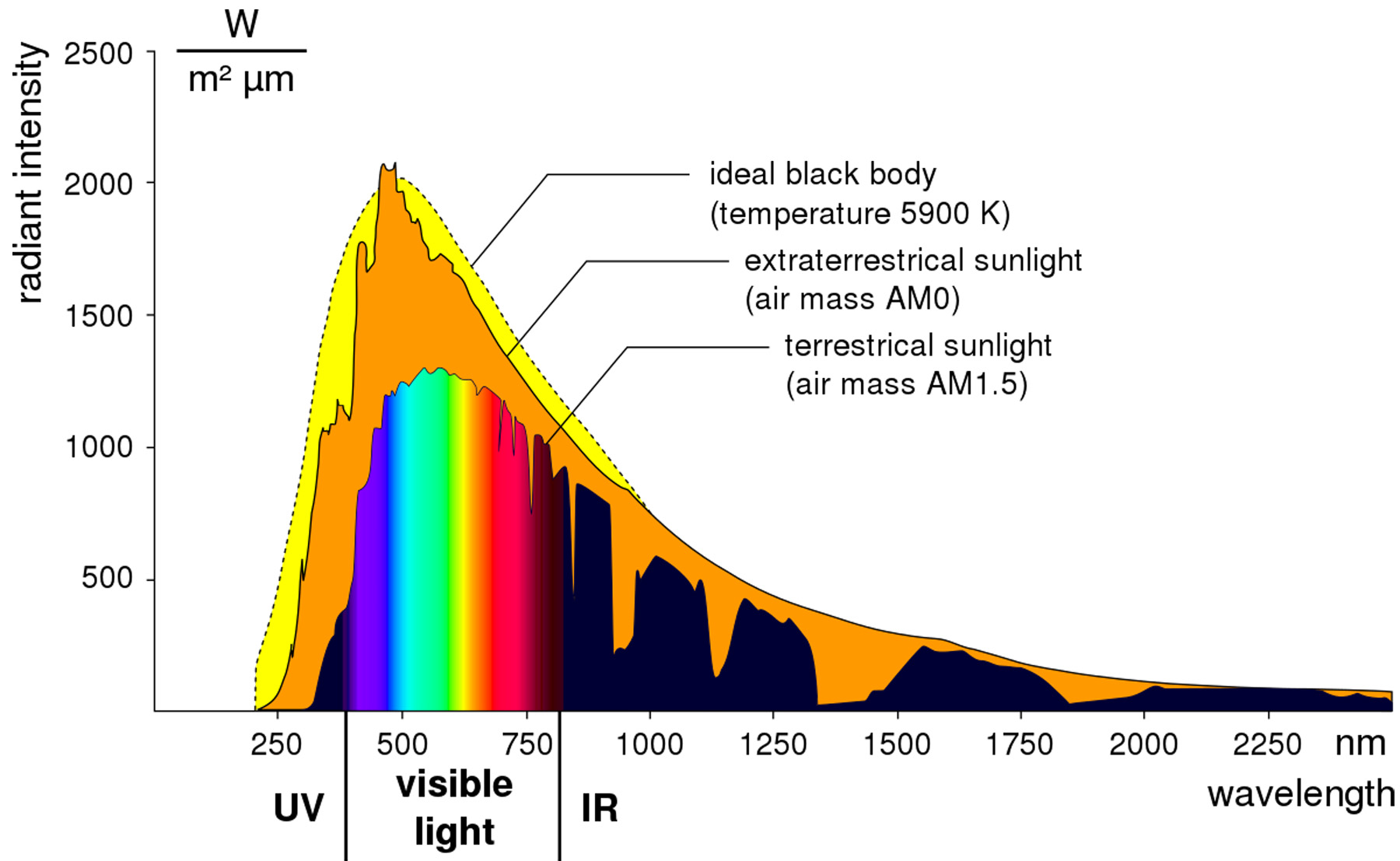
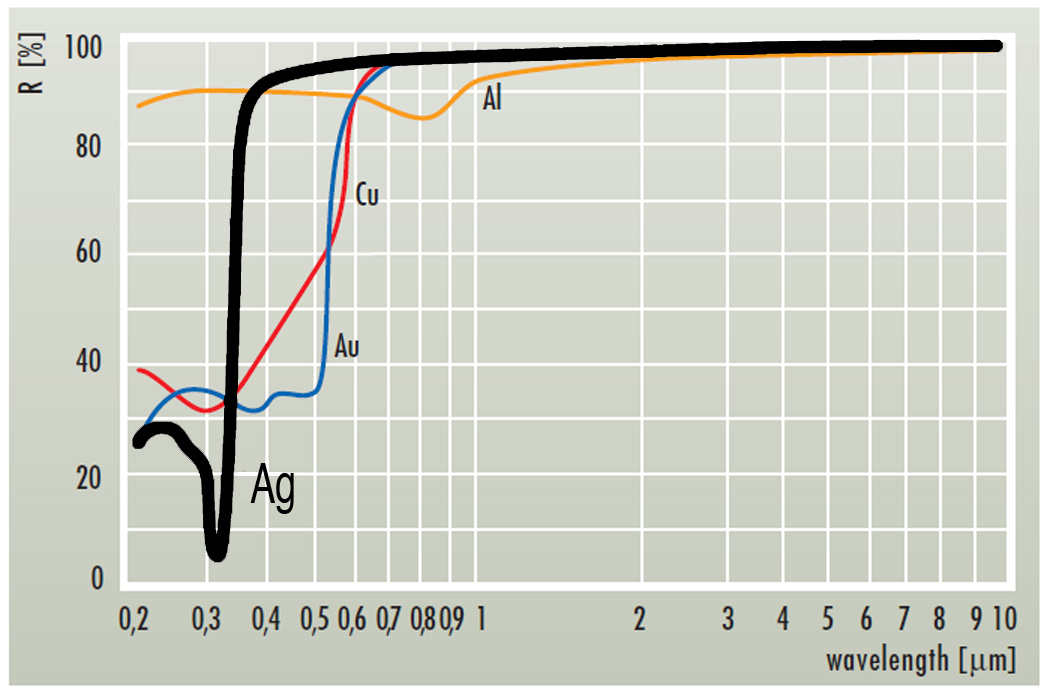
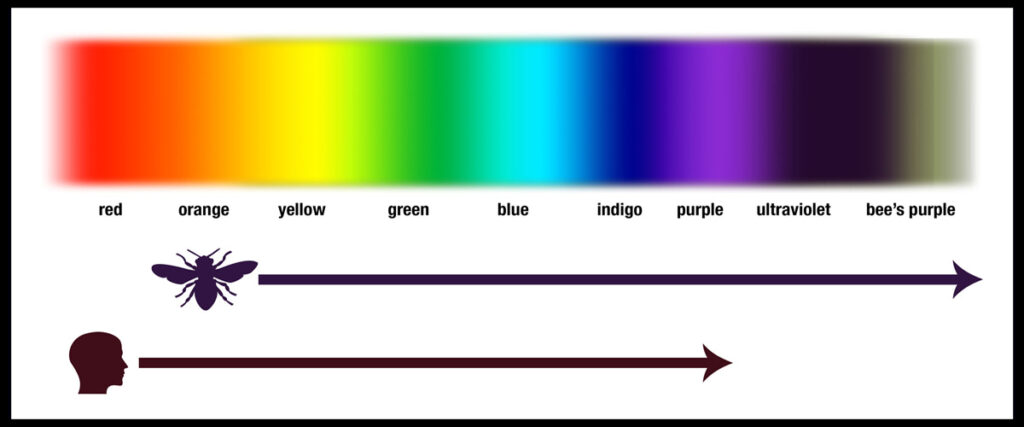
For one unit, the projected area of sunlight reflected by the mirrors is 66m2, with an intensity of 1370 W/m2. Taking into account reflection losses through the mirrors and transmission losses through the double layered transparent membrane window, approximately 65kW of sunlight enter each greenhouse. On the given floor area of 245m2 the radiation intensity is 265W/m2 in average.
With a wavelength spectrum close to that on Earth´s surface, this results in a light intensity of 15.000-16.000 lux, the optimum for photosynthesis. In order to give plants a rest, and also unburden the cooling system, for 4-5 hours each day nocturnal darkness is simulated by simply turning the mirrors away from the Sun.
On Earth light intensity even reaches 100.000 lux on a clear summer day at noon, but this additional amount of light cannot be used for photosynthesis by most plants.
To get the right idea of physical and subjectively perceived light intensity:
- 2 lux: the shine of moon light at night
- 50 lux: is enough for a cozy bedroom illumination
- 500 lux: in a living room indoor might have at daytime.
- 1000 lux: from that on photosynthesis starts slowly
- 15.000 lux is the optimum for photosynthesis and outdoor lightness on a bright winter day
- 100.000 lux on a very bright summer day
- 150.000 lux can be the maximum in Sahara-desert
The human eye can adapt within that range
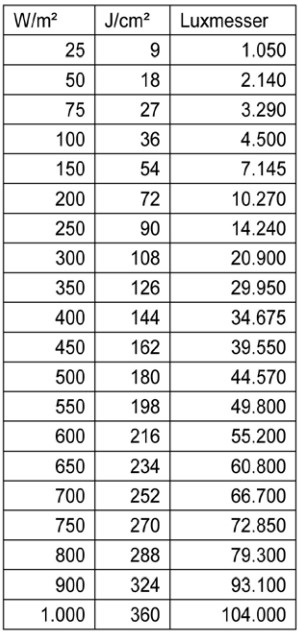
In moderate climate zones even 15.000lux are not reached most of the time, at night, sunrise, sunset, from November to March, with fog, rain, and cloudy sky.
Additionally, even when illumination is optimal or abundant, photosynthesis only works at the right temperature and with the right amount of water. It starts at about +5°C and raises with the temperature to a peak at 25°- 26° for most plants. At higher temperature it decreases. Also, with a shortage of water, plants stop their water- emitting photosynthesis even at optimal light and temperature level.
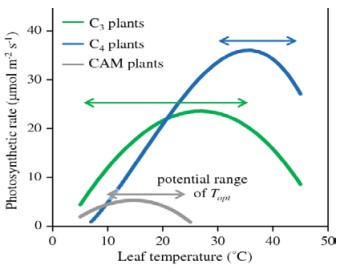
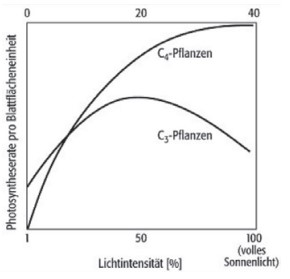
Under the optimal lighting conditions and optimal temperature, each of these modular greenhouses can supply 2 humans. An array of 16 greenhouses can form a habitat for 32 crew members. Inside the greenhouses we can grow a variety of fruits, nuts and vegetable for nutrition.
Insects can be part of the ecosystem for pollination and recycling of organic waste. Their larvae can supplement the diet for animal protein.
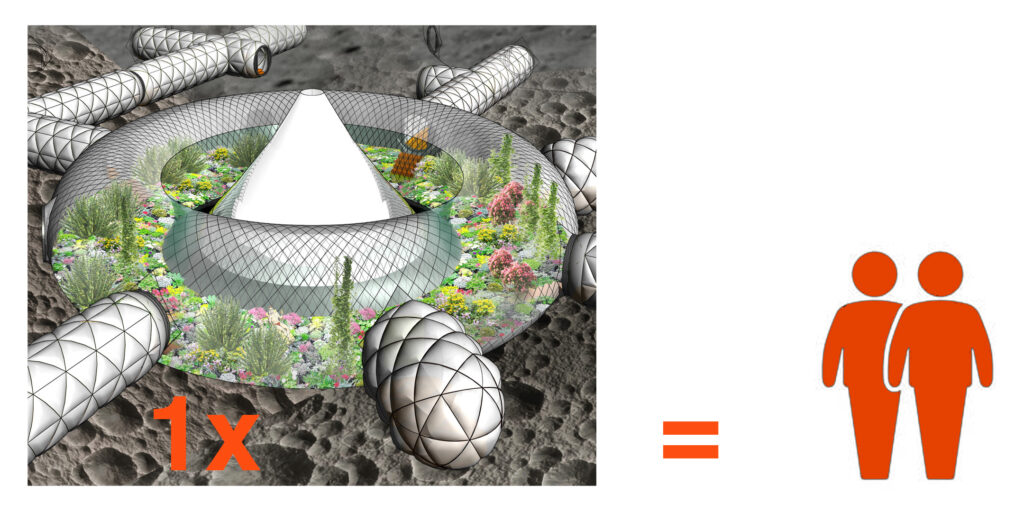
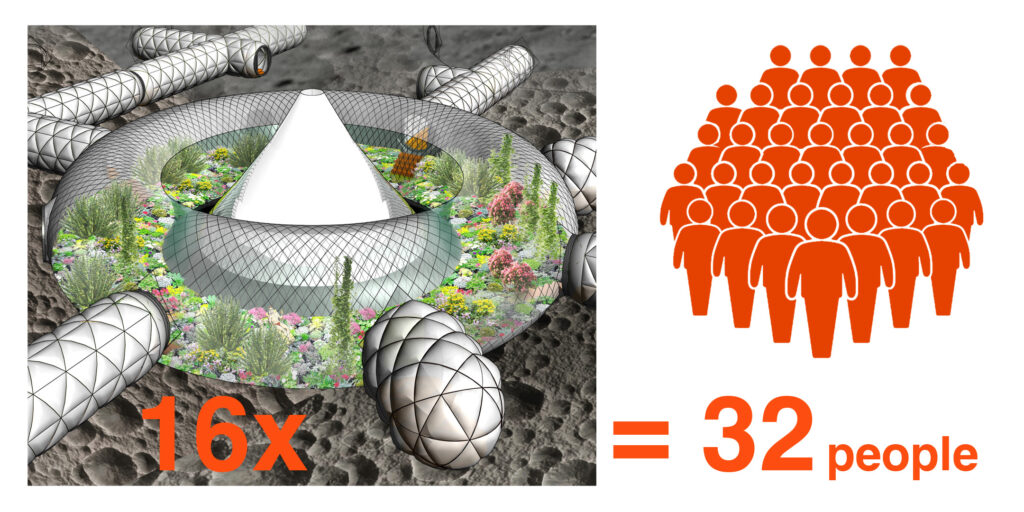
Recycling of Resources
Through photosynthesis plants convert CO2 and water into carbohydrate and Oxygen:
Photosynthesis: 6 H2O + 6 CO2 = 6 O2+ C6H12O6
Only photosynthesis in combination with composting of organic waste, guarantees a 100% recycling of oxygen, hydrogen and carbon. No machine can manage that so far. With the Sabatier process on the ISS, oxygen is recycled but with methane (that cannot be used in the habitat) hydrogen and carbon are released into space. Since there is no carbon on the Moon, it is a big advantage, when it can be fully recycled and does not need to be supplied from Earth permanently.
Sabatier process: CO2 + 4 H2 => CH4 + 2 H2O

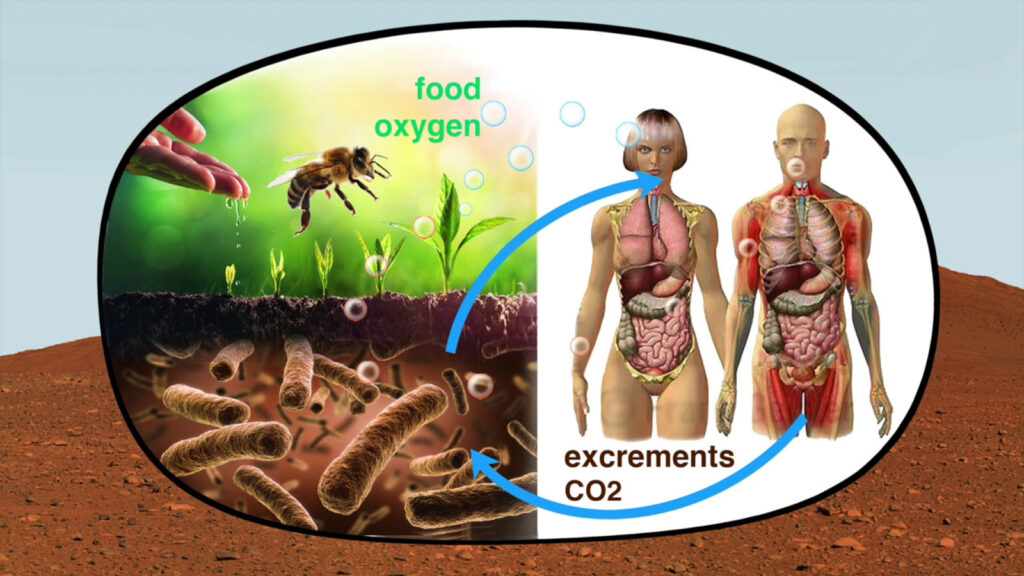
Experiments already have proven that moon regolith and Mars regolith can be upgraded to fertile soil when processed and enriched with the right additives.
Blue Horizon, a company located in Luxembourg, has developed methods to convert desert sand or Moon regolith into fertile soil with algae and microorganisms.
Professor Wieger Wamelink , at Wageningen University in the Netherlands already has successfully grown crops in Mars- and Moon regolith simulant, that has been prepared with organic waste and worms.
In order to convert the lunar regolith into fertile soil in the greenhouse, the initial amount of carbon, nitrogen and other substances important for organic compounds required to start the ecological cycle must first be brought from Earth. These substances are best supplied in the form of food.
This gives the team food supplies for the initial period when no food is produced in the greenhouse The human excrement is gradually composted for fertile soil, allowing more areas of the greenhouse to gradually produce food and oxygen.
We can start the biological cycle, when we have sufficient oxygen, CO2 and Nitrogen in the air, plus water and carbohydrates in form of excrements and organic waste inside the regolith soil.
CO2 is exhaled by the crew and other living organisms and then photosynthesized by plants and released as Oxygen into the air. Plants grow and are harvested. Some of their organic matter is eaten by the crew, the rest is eaten or composted by other aerobic organisms.
In one greenhouse unit, up to 500 liters of water vaporize from transpiration of the plants every day and condense on the cooling radiators on the ceiling, from where the water can be collected. Drinkable water or juice also can be squeezed out from fruits and leaves that grow there.
On the ISS or any other space habitat without a natural greenhouse, water would need to be extracted and recycled from dehumidifying air, filtering and distilling waste water and vaporizing water from excrements. This requires almost 1kWh per liter of water. All these facilities and energy for recycling oxygen and water are not required here, because it is done by the plants.
To start the biological cycle, these are the most important substances we need to bring into the greenhouse first:
Moon regolith, cleaned from toxic substances as a base for soil
Carbon from Earth, since there is almost no carbon on the Moon
Nitrogen from Earth, since there is almost no nitrogen on the Moon
Water: that can be mined on the Moon
Oxygen, brought from Earth and/or electrolysed from water that previously has been mined on the moon.
Carbon should be best brought to the Moon in form of food which will be consumed by the crew during the time when the greenhouse is not productive yet.
Nitrogen is also contained in food but additionally can be brought in a volume-saving way as ammonium nitrate (NH4NO3) that thereupon will be converted into nitrogen, water and oxygen: NH4NO3 = 2H2O+N2 +1⁄2O2 . For safety reasons it should be solved with water.
With enough oxygen, CO2 and Nitrogen in the air, plus water, Nitrates and carbohydrates in form of excrements and organic waste inside the regolith soil, we can start the biological cycle:
CO2 exhaled by the crew and other living organisms is photo-synthesized by plants and released as Oxygen and water into the air. Plants grow and are harvested. Some of their organic matter is eaten by the crew, the rest is eaten or composted by other aerobic organisms. Inside the toilet bowl excrements are collected in biodegradable waste-bags. These bags are put into an oven and sterilized at 120°C. Inside the oven we provide an overpressure of 2 bar, so the water contained in the excrements does not boil.
Together with other organic waste the sterilized excrements are brought into a composting chamber, that is linked to the greenhouse. Worms, fungi and microorganisms convert the organic waste into fertile humus soil, which thereupon is added to the soil in the greenhouse.
When plants grow faster than they are eaten or composted, they bind carbon and the oxygen level in the air rises and the CO2 level decreases.
When they are eaten or composted faster than they can grow, the CO2 level rises and the O2 level decreases.
Also it cannot work to let plants grow continuously, without eating or composting them and without adding more CO2 from outside. Sooner or later all CO2 would be used up and plants must stop growing and die.
As investigations discovered, in the Biosphere2 experiment CO2 got lost permanently, because it was chemically absorbed by the concrete walls.
Plants could not grow sufficiently and therefore could not produce enough oxygen either. Additional CO2 to substitute the loss, could only come
from dead composting organic matter.
While additional oxygen can be electrolyzed from mined water, there is no way to get new carbon except from Earth. For this reason sufficient presence of carbon is even more critical than that of oxygen.
The goal is to keep the level of both, oxygen and CO2, high enough.
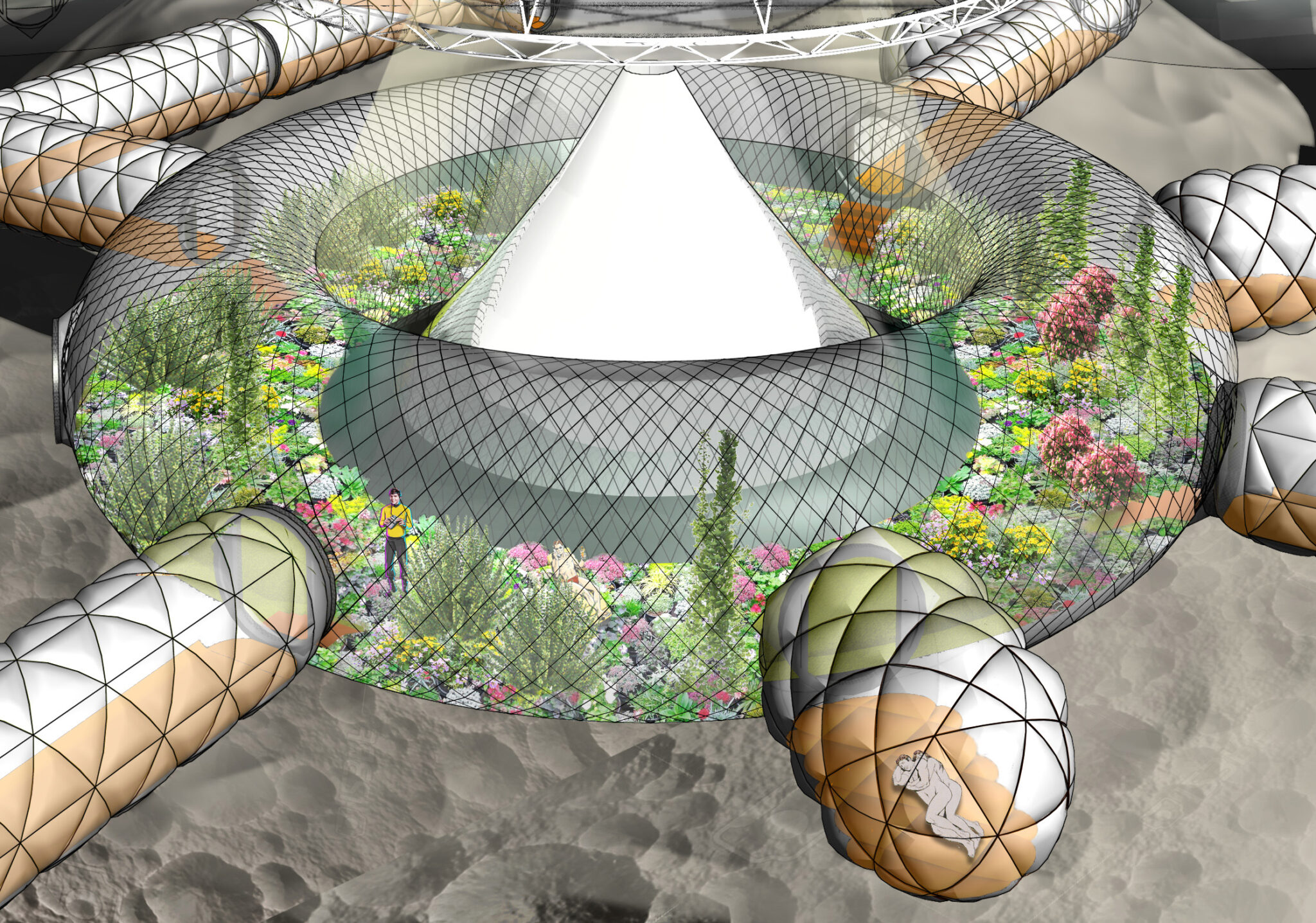
Other concepts usually include aeroponic food production in plastic shelves under purple LED light. But unlike natural soil, aeroponics do not include the composting of organic waste and depend on artificial nutrition solvent sprayed on the roots. There is extra payload for the shelves, the LED-lamps and the pipe-system for watering. 22
Usually, plants need 250 Watt of sunlight per m2 for optimal photosynthesis. Even when we assume that LED light is a bit more efficient by using the most relevant light spectrum only, the production of the electricity through PV-Modules is by far not as efficient as natural sunlight after reflection of the mirrors.
Additionally, we have to make sure that the crew members don’t get depressed in the artificial environment.
A short walk in a space suit through the barren, radiation-polluted lunar landscape cannot replace a walk in the forest on Earth, nor can shelves flooded with purple light.
But spacious greenhouses with natural sunlight, lush vegetation and biodiversity are not only a source of oxygen and food. Here humans experience a natural environment full of sunlight, where they see and smell different plants and hear the buzzing of bumblebees.